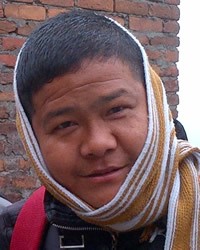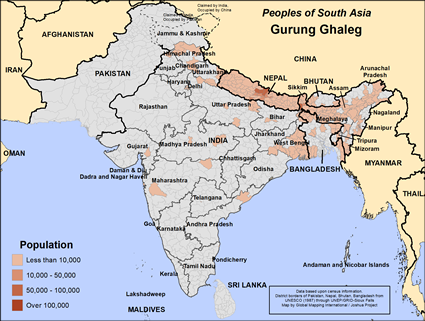Gurung Ghaleg in Nepal

Photo Source:
Timothy Two Project International
|

Map Source:
People Group data: Omid. Map geography: UNESCO / GMI. Map Design: Joshua Project.
|
| People Name: | Gurung Ghaleg |
| Country: | Nepal |
| 10/40 Window: | Yes |
| Population: | 547,000 |
| World Population: | 674,000 |
| Primary Language: | Gurung |
| Primary Religion: | Buddhism |
| Christian Adherents: | 5.01 % |
| Evangelicals: | 0.00 % |
| Scripture: | New Testament |
| Ministry Resources: | Yes |
| Jesus Film: | Yes |
| Audio Recordings: | Yes |
| People Cluster: | South Asia Buddhist |
| Affinity Bloc: | South Asian Peoples |
| Progress Level: |
|
Introduction / History
The Western Gurung people live in the Kaski, Syangia and Parbat districts of the Gandaki Zone in central Nepal. According to the 1991 census, 72,000 people can still speak the Western Gurung language, just over 50 per cent of the population. The rest speak Nepali as their first language.
Over the past two hundred years the Gurung have migrated into surrounding nations. There is a community of Gurung living in the Samtsi District of south-west Bhutan, where they are commonly labelled as Nepalis. In India, Gurung communities can be found in the hilly terrain of the South, West and East districts of the state of Sikkim, throughout the Darjeeling District of West Bengal, and around the city of Dehra Dun and throughout the Pithoragarh District in Uttar Pradesh. In India, the Gurung have not been recognized as a Scheduled Tribe. Consequently population figures are not available for them, but they probably total a few thousand.
Gurung history is clouded with uncertainty because of their lack of a written script in the past. Legends were handed down orally from one generation to the next. We do know that, during the 15th century, a Gurung king named Ghale Raja was overthrown by a Nepali king. In the 16th century the Khasa armies took over large tracts of land in Nepal and the Gurung came under their control.
What Are Their Lives Like?
The Gurung were highly regarded as fighters and many of them were enlisted in the Khasa's armies. Later, after the British took control of India, many Gurung men were enlisted as Gurkha soldiers in the British army. Thousands have served in places from Hong Kong to Bosnia and the Falkland Islands.
What Are Their Beliefs?
Religion plays an important role in the everyday lives of most Gurung people. Their belief system is a mixture of Buddhism, Hinduism and shamanism. As one researcher wrote, 'Buddhism is followed by the Gurungs today although in ancient times they practiced the animistic and shamanistic form of religion like the pre-Buddhist Bon religion of the Himalayan regions. The northern areas of the kingdom are populated with people of mongoloid stock who are mostly followers of Tibetan Buddhism, and so these Gurungs can also be included within this category, though currently Hindu Gurungs have also emerged due to their contact with the Hindu lowlanders. '
The ceremonies and rituals that the Gurung perform also have mixed origins. One interesting custom, called tuno bandhane, takes place three days after the birth of a baby. 'This entails wrapping the newborn baby (after it has been washed in either cow's milk or cow's urine) in a long piece of cloth. '
Less than one out of every thousand Western Gurung people are Christians today.
What Are Their Needs?
The Western Gurung New Testament was first published in 1982, but it has fallen out of print since because of the small number of Western Gurung Christians and because there is no demand for it.
Prayer Points
Pray for a hunger for the word of God among the Western Gurung people.
Pray for the Lord to thrust out dedicated workers to them.
Pray for Western Gurung disciples to make more disciples.